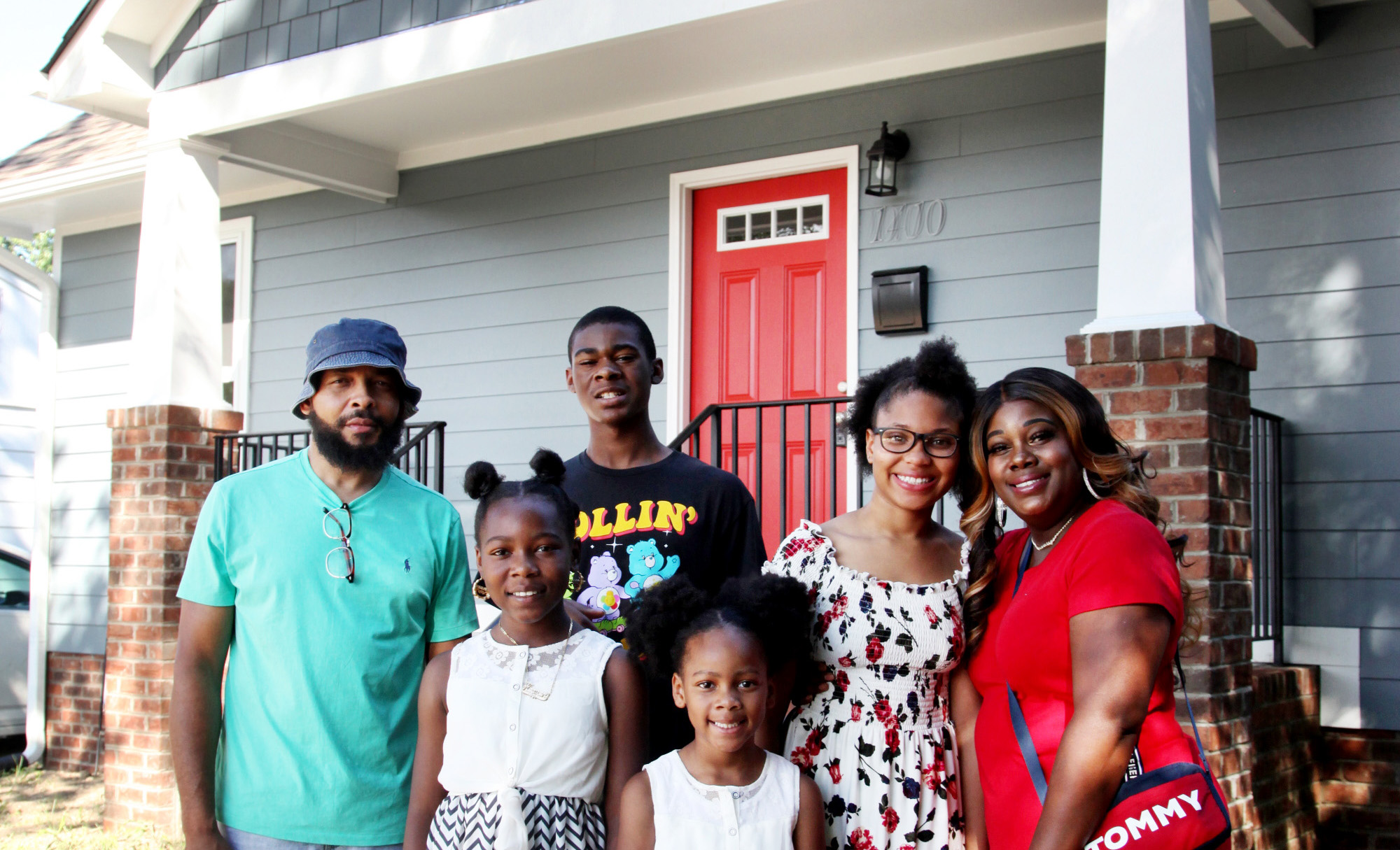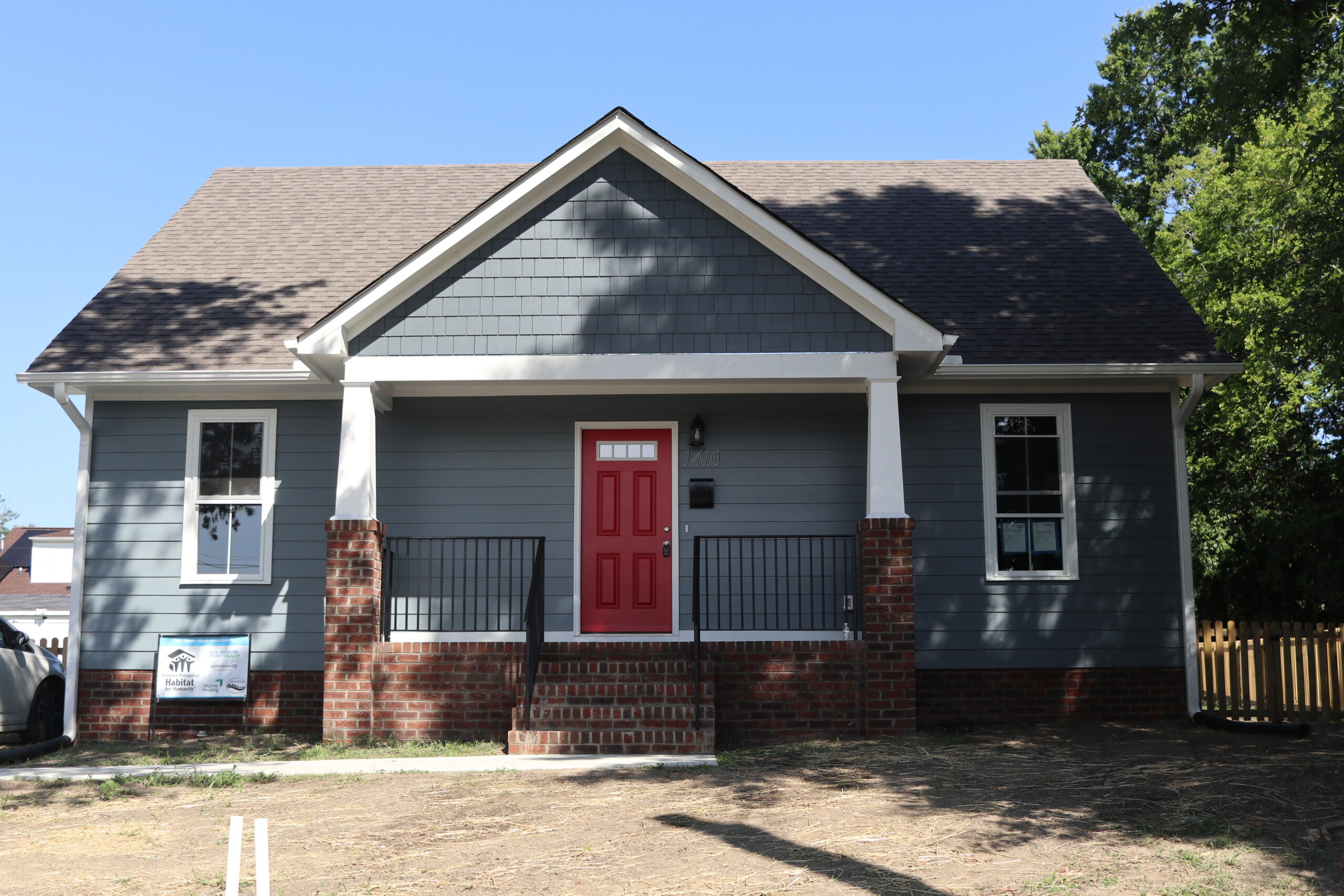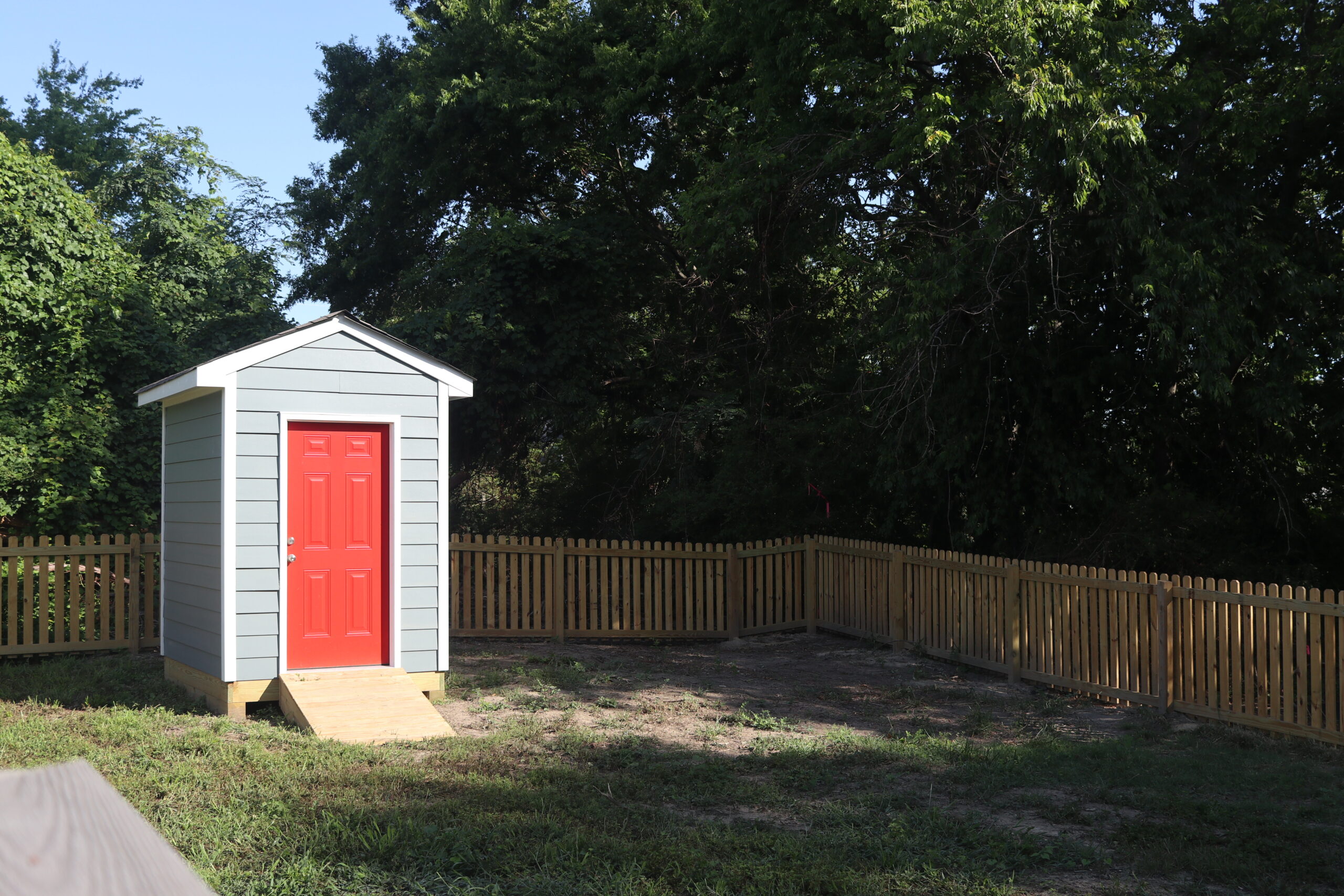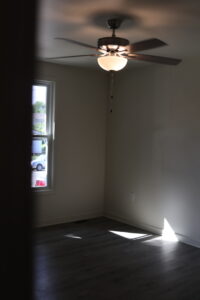
The Adams family will soon be buying this home built by Richmond Metropolitan Habitat for Humanity. They had to put a $1,000 deposit down on the house and provide hundreds of volunteer hours in sweat equity. (Photo courtesy of Rebecca D’Angelo)
The first house funded through the region’s planning district commission has been completed by the Richmond Metropolitan Habitat for Humanity. The home will soon be purchased by a family of six.
The nearly 1,700-square-foot Church Hill-area house is the region’s first to be constructed with funds allocated by PlanRVA, which serves as the planning district commission for the Richmond area. It works to promote intergovernmental cooperation around infrastructure and land use, which includes housing considerations.
PlanRVA is one of 21 such commissions in Virginia, regional subdivisions established in 1968 by the commonwealth. PlanRVA encompasses nine counties of the greater Richmond area, from Goochland to New Kent.
Each county elects a number of members based on its population to the commission, who meet monthly. Richmond has four members on the board.
The investment was made possible a year ago, when Virginia Housing (formerly VHDA) set up a $40 million PDC Housing program to deal with the state’s affordable housing shortage. Plan RVA received $3 million, with the catch that the money could only be used to create new income-based units, whether rented or owned.

This Church Hill-area house is the first to be completed using the PlanRVA funds. (Filip De Mott photos)
According to PlanRVA’s website, to meet the program’s guidelines, each unit must go to residents who earn equal to or under 80 percent of the area’s median income, or AMI.
To decide on the funding’s use, the PDC joined efforts with The Partnership for Housing Affordability, a research and policy organization frequently collaborating with local nonprofits.
The group decided to split the $3 million between a larger jurisdiction, encompassing Richmond, Chesterfield and Henrico, and a smaller jurisdiction pool of outlying counties. Nonprofits applied for the funding based on their construction needs.
“Three million dollars is a lot of money, but, in housing terms, $3 million can be whittled away pretty quickly,” PHA Executive Director Jovan Burton said. “I wanted to make sure we were using the funds strategically.”
Nonprofit applicants had to also demonstrate other sources of funding for their development projects, said Martha Heeter, PlanRVA’s executive director.
The PDC Housing program requires that funded projects be completed and inhabited by July 1, 2024. For that reason, the group only allocated money to projects that were shovel ready.
They granted the Richmond Metropolitan Habitat for Humanity $350,000 to construct seven units in the city and $83,128 to build two units in Chesterfield County.
Before the allocated funds, a nonprofit’s financial strategies included tax credit programs, annual grants and philanthropy, Burton said. The $3 million will help put a dent in what’s estimated as a shortage of 20,000 affordable units in the region.
“This funding has really helped to accelerate, but also keep on pace a lot of projects that otherwise would have been significantly delayed,” Burton said, citing rising construction costs and supply chain issues.
According to city permits, Habitat purchased the Church Hill-area lot for $25,000 in 2020, after the previous owner, Tricycle Gardens, closed down that same year. The land is currently valued at $52,000.
Construction on the four-bedroom dwelling took seven to eight months, slightly longer than usual, with a material cost of around $180,000.
Habitat for Humanity is supported by a base of volunteers, which helps save around $54,000 per project, said CEO Mary Kay Huss, citing a pre-pandemic analysis done by the nonprofit. The new home was constructed by 163 unique and 19 repeating volunteers.
The organization accepts and houses around 10 to 12 in-need families, a number it’s hoping to double over the course of five years.
Applications start in March and this year the nonprofit received 200. To qualify, applicants must meet a number of criteria based on credit, income and housing history.
The Church Hill-area house will belong to John and Tanya Adams and their four children. Before they applied through Habitat, the family lived in substandard accommodations with exposed lead, mold and a lack of insulation. Some of their children have since developed asthma.
“We’re extremely blessed, extremely grateful for the help and everything you guys have done for us,” Tanya said at a recent open house event. “It’s been a trying road.”
John Adams, an Air Force veteran, worked maintenance at an apartment complex until becoming medically disabled. Meanwhile, COVID ended Tanya’s job in cosmetics.
The couple found out about Habitat’s program after receiving a postcard from the group. They were not selected their first year but could apply annually.
“Don’t be discouraged,” John said, advising anyone who gets rejected. “Next time, try to have your credit score, your finances up there. Give it a try.”
Once accepted, Habitat members first pay $1,000 or 1 percent of the final purchase price of their new home. They also volunteer for 350 hours, aiding in the construction of their and other Habitat houses while attending meetings and classes. Veterans are only prescribed 200 hours.
Once a family moves in, Habitat for Humanity ensures affordability by taking the role of a bank.
According to Huss, housing is deemed unaffordable when owners commit more than 30 percent of their gross monthly income towards mortgage or rent. The nonprofit allows a member family to commit no more than 25 percent toward this, averaging around $600 to $700 a month.
Once a Habitat family’s house is finished, it moves in and enters into a 30-year mortgage agreement, with a rate based on what the family can afford. Any second mortgages issued can become forgivable overtime.
Huss expects the home’s appraisal value to be around $225,000.
In addition to the PlanRVA funding, Habitat for Humanity depends on the financial support of its sponsors. The Bon Secours health system, The Community Foundation, PlanRVA, The City of Richmond and Hamilton Beach assisted the nonprofit with the property.
Habitat continues progressing on its other units, some of which are also near completion. It has also begun piloting a new rental program, offering two properties for rent, also in North Church Hill. According to a news release, the rental program offers homes to households with 30 to 50 percent AMI. In 2023, Habitat will begin construction on four more rental units in the city.
“It’s kind of a pathway to home ownership, the pipeline. It helps our families that we’re working with,” Huss said. “But, as we expand, we can offer it to the community as well.”
The PlanRVA-PHA group has also been funding other nonprofits, including Project:HOMES, Better Housing Coalition, Maggie Walker Community Land Trust and Virginia Supportive Housing. It has allotted $265,000 to help fund a total of 272 units, including an apartment and motel.

The Adams family will soon be buying this home built by Richmond Metropolitan Habitat for Humanity. They had to put a $1,000 deposit down on the house and provide hundreds of volunteer hours in sweat equity. (Photo courtesy of Rebecca D’Angelo)
The first house funded through the region’s planning district commission has been completed by the Richmond Metropolitan Habitat for Humanity. The home will soon be purchased by a family of six.
The nearly 1,700-square-foot Church Hill-area house is the region’s first to be constructed with funds allocated by PlanRVA, which serves as the planning district commission for the Richmond area. It works to promote intergovernmental cooperation around infrastructure and land use, which includes housing considerations.
PlanRVA is one of 21 such commissions in Virginia, regional subdivisions established in 1968 by the commonwealth. PlanRVA encompasses nine counties of the greater Richmond area, from Goochland to New Kent.
Each county elects a number of members based on its population to the commission, who meet monthly. Richmond has four members on the board.
The investment was made possible a year ago, when Virginia Housing (formerly VHDA) set up a $40 million PDC Housing program to deal with the state’s affordable housing shortage. Plan RVA received $3 million, with the catch that the money could only be used to create new income-based units, whether rented or owned.

This Church Hill-area house is the first to be completed using the PlanRVA funds. (Filip De Mott photos)
According to PlanRVA’s website, to meet the program’s guidelines, each unit must go to residents who earn equal to or under 80 percent of the area’s median income, or AMI.
To decide on the funding’s use, the PDC joined efforts with The Partnership for Housing Affordability, a research and policy organization frequently collaborating with local nonprofits.
The group decided to split the $3 million between a larger jurisdiction, encompassing Richmond, Chesterfield and Henrico, and a smaller jurisdiction pool of outlying counties. Nonprofits applied for the funding based on their construction needs.
“Three million dollars is a lot of money, but, in housing terms, $3 million can be whittled away pretty quickly,” PHA Executive Director Jovan Burton said. “I wanted to make sure we were using the funds strategically.”
Nonprofit applicants had to also demonstrate other sources of funding for their development projects, said Martha Heeter, PlanRVA’s executive director.
The PDC Housing program requires that funded projects be completed and inhabited by July 1, 2024. For that reason, the group only allocated money to projects that were shovel ready.
They granted the Richmond Metropolitan Habitat for Humanity $350,000 to construct seven units in the city and $83,128 to build two units in Chesterfield County.
Before the allocated funds, a nonprofit’s financial strategies included tax credit programs, annual grants and philanthropy, Burton said. The $3 million will help put a dent in what’s estimated as a shortage of 20,000 affordable units in the region.
“This funding has really helped to accelerate, but also keep on pace a lot of projects that otherwise would have been significantly delayed,” Burton said, citing rising construction costs and supply chain issues.
According to city permits, Habitat purchased the Church Hill-area lot for $25,000 in 2020, after the previous owner, Tricycle Gardens, closed down that same year. The land is currently valued at $52,000.
Construction on the four-bedroom dwelling took seven to eight months, slightly longer than usual, with a material cost of around $180,000.
Habitat for Humanity is supported by a base of volunteers, which helps save around $54,000 per project, said CEO Mary Kay Huss, citing a pre-pandemic analysis done by the nonprofit. The new home was constructed by 163 unique and 19 repeating volunteers.
The organization accepts and houses around 10 to 12 in-need families, a number it’s hoping to double over the course of five years.
Applications start in March and this year the nonprofit received 200. To qualify, applicants must meet a number of criteria based on credit, income and housing history.
The Church Hill-area house will belong to John and Tanya Adams and their four children. Before they applied through Habitat, the family lived in substandard accommodations with exposed lead, mold and a lack of insulation. Some of their children have since developed asthma.
“We’re extremely blessed, extremely grateful for the help and everything you guys have done for us,” Tanya said at a recent open house event. “It’s been a trying road.”
John Adams, an Air Force veteran, worked maintenance at an apartment complex until becoming medically disabled. Meanwhile, COVID ended Tanya’s job in cosmetics.
The couple found out about Habitat’s program after receiving a postcard from the group. They were not selected their first year but could apply annually.
“Don’t be discouraged,” John said, advising anyone who gets rejected. “Next time, try to have your credit score, your finances up there. Give it a try.”
Once accepted, Habitat members first pay $1,000 or 1 percent of the final purchase price of their new home. They also volunteer for 350 hours, aiding in the construction of their and other Habitat houses while attending meetings and classes. Veterans are only prescribed 200 hours.
Once a family moves in, Habitat for Humanity ensures affordability by taking the role of a bank.
According to Huss, housing is deemed unaffordable when owners commit more than 30 percent of their gross monthly income towards mortgage or rent. The nonprofit allows a member family to commit no more than 25 percent toward this, averaging around $600 to $700 a month.
Once a Habitat family’s house is finished, it moves in and enters into a 30-year mortgage agreement, with a rate based on what the family can afford. Any second mortgages issued can become forgivable overtime.
Huss expects the home’s appraisal value to be around $225,000.
In addition to the PlanRVA funding, Habitat for Humanity depends on the financial support of its sponsors. The Bon Secours health system, The Community Foundation, PlanRVA, The City of Richmond and Hamilton Beach assisted the nonprofit with the property.
Habitat continues progressing on its other units, some of which are also near completion. It has also begun piloting a new rental program, offering two properties for rent, also in North Church Hill. According to a news release, the rental program offers homes to households with 30 to 50 percent AMI. In 2023, Habitat will begin construction on four more rental units in the city.
“It’s kind of a pathway to home ownership, the pipeline. It helps our families that we’re working with,” Huss said. “But, as we expand, we can offer it to the community as well.”
The PlanRVA-PHA group has also been funding other nonprofits, including Project:HOMES, Better Housing Coalition, Maggie Walker Community Land Trust and Virginia Supportive Housing. It has allotted $265,000 to help fund a total of 272 units, including an apartment and motel.



Wow. Habitat built a house, and based on the length of the story, thanks be to God the affordable housing crisis is over. Because it is not just this one but 12 or so others that Plan RVA’s $3 million will allow to happen. This story could have used more leaven and less yeast.
It’s refreshing to see a story about people who are trying to address the critical housing shortage in Richmond. I would rather read about this instead of the stories about big money developers who refuse to release projections on rent prices (if you have to ask the price you probably can’t afford it), accompanied by discussions about bike lanes and craft breweries.